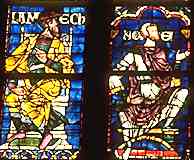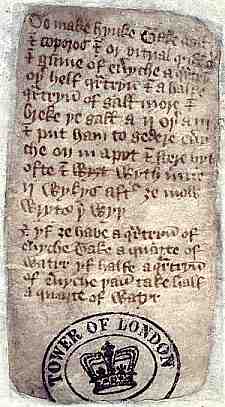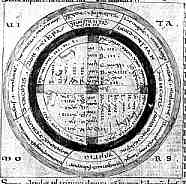


If you are looking at this page without frames, there is more information about medieval writing to be found by going to the home page (framed) or the site map (no frames).
| Works on Science (2) | ||||||
 |
The manufacture of glass involves chemical transformation, and the knowledge of that process is refined when it involves the production of the vivid translucent colours of stained glass windows. As with the manufacture of pigments and paints, coloured glassmaking requires a knowledge of natural minerals and their properties, as well as a knowledge of what happens to them when they are transformed in a glassmaking furnace. But this practical information is not found in the medieval books of knowledge. | |||||
| 12th century stained glass figures from Canterbury Cathedral. | ||||||
| 14th century fashions. | ||||||
| The dyers who turned cloth into brilliant fashionable colours had experimental knowledge of how substances behave and change under certain circumstances, and had to be able to pass the test of reproducibility, so important in modern chemistry, if his lordship's robe was going to turn out the way his lordship had ordered it. The same applies to those who turned skin into leather or parchment, or who made glue, or exquisite enamel jewellery, or for that matter bread. However, modern knowledge of how these things were done in the middle ages has been more often acquired by working backwards from the objects themselves, investigating what they contained and how they were put together, rather than by reading treatises on the subjects. | ||||||
 |
A 15th century recipe for ink (London, National Archives C. 47/34/1/3), by permission of the National Archives. | |||||
| The item at left is, in fact, a recipe for a chemical process in written form. It is a bit of practical science. However, it is a description of how to carry out the process for the manufacture of iron gall ink, not a scientific explanation of why it works. It was also produced by a scribe of the English royal chancery. If anybody was going to put their practical knowledge into literate mode, they were. After all, writing was their practical trade. | ||||||
| See the section on Inks and Colourings. | ||||||
| Mathematics was an area where literate knowledge had an interesting history in the middle ages. Classical texts on mathematics became lost to western Europe in the early days of Latin literacy, because the church as the custodian of literate knowledge concentrated on matters of more pressing concern to itself. However, texts on Greek mathematical scholarship passed into the Arab world where they combined with other eastern branches of the discipline, then later found their way back into western Europe via Muslim Spain and other routes of communication. It is a complex story. | ||||||
| Of the many branches of what we call mathematics today, the areas that were most significant in these works included geometry, and aspects of astronomy, which were themselves utilised in the computation of time. This was of interest to the church in relation to the complex calculations required to calculate the liturgical calendar over the course of the years. |  |
|||||
| See the sections on Dating and Reading a Calendar. | ||||||
| Late 11th century diagram from a computistical work (British Library, Cotton Caligula A XV, f.125v). By permission of the British Library. | ||||||
| The ability to carry out complex numerical calculations was hindered by the fact that Arabic numerals were not in general use until the late middle ages, although there were a few mathematical writers who had knowledge of them, as early as the 12th century in England. Roman numerals are not user friendly for computation. Just try it. Have a go at long division using Roman numerals. Reckoning was carried out using the abacus or counters, or by tricky methods of doing computation on the fingers. Units of measurement were also very unstandardised in the medieval period. | ||||||
| See the section on Weights, Measures and Money. An interesting little book on the subject of medieval arithmentic is Yeldham, F.A. 1926 The Story of Reckoning in the Middle Ages London: George G. Harrap & Co.Ltd. | ||||||
| What is not apparent in the medieval written record are some branches of applied mathematical knowledge such as are used by modern engineers and builders to compute stresses, loads, thrusts, trajectories and all manner of forces that determine where things go, how fast, or whether stationary objects can stay upright. This leads us to an interesting dilemma. | ||||||
| The totally awe inspiring Amiens Cathedral; at left the interior from the west looking from the nave to the apse, showing the stupendous elevation; at right, the exterior of the apse from the east, showing what holds it up. | ||||||
| The development of Gothic architecture, and especially the extreme forms in which huge high elevations containing large sheets of glass are supported by slender flying buttresses would appear to be impossible to build without the ability to make such computations. There are those who seem to believe that master masons were great gamblers who took high risks and hoped, but there was too much money pledged by the church and lay sponsors to make that seem very likely. And while things sometimes did fall down, it wasn't all that often. Unbelievable structures like Amiens Cathedral are still there after hundreds of years. What is not left in the written record is how the engineering knowledge which they must have had, albeit knowledge that was gradually accrued by experience, was actually conceptualised or how it was passed on. There are no manuals on how to buld a Gothic cathedral. It is science, but it is not written down. It is knowledge, but it is not literate. | ||||||
| In fact, the underestimating of the engineering knowledge of medieval masons has had consequences. When this late medieval stone choir screen was removed for aesthetic reasons in that most mathematical of centuries, the 19th, the spire of the central tower collapsed. They did not realise that it was buttressing the forces of the tall central tower. After they rebuilt the tower, the stone screen was put back. Medieval science beats Victorian arty sensibilities. | ||||||
| Stone choir screen in Chichester Cathedral. | ||||||
| |
||||||
|
If you are looking at this page without frames, there is more information about medieval writing to be found by going to the home page (framed) or the site map (no frames). |
||||||